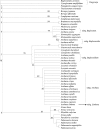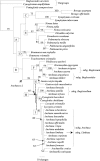Molecular systematics of Boraginaceae tribe Boragineae based on ITS1 and trnL sequences, with special reference to Anchusa s.l
- PMID: 15271774
- PMCID: PMC4242157
- DOI: 10.1093/aob/mch132
Molecular systematics of Boraginaceae tribe Boragineae based on ITS1 and trnL sequences, with special reference to Anchusa s.l
Abstract
Background and aims: Boragineae is one of the main tribes of Boraginaceae, but delimitation and intergeneric classification of this group are unclear and have not yet been studied using DNA sequences. In particular, phylogenetic relationships in Anchusa s.l. still need to be elucidated in order to assess its taxonomic boundaries with respect to the controversial segregate genera Hormuzakia, Gastrocotyle, Phyllocara and Cynoglottis.
Methods: Phylogenetic relationships among 51 taxa of tribe Boragineae were investigated by comparative sequencing of the trnL(UAA) intron of the plastid genome and of the ITS1 region of the nuclear ribosomal DNA. Exemplar taxa from 16 genera of Boragineae and all subgenera of Anchusa s.l. were included, along with two selected outgroups from tribes Lithospermeae and Cynoglosseae.
Key results: Phylogenies generated by maximum parsimony and combined ITS1-trnL sequences support the monophyly of the tribe and a split into two clades, Pentaglottis and the remainder of Boragineae. The latter contains two large monophyletic groups. The first consists of three moderately to well-supported branches, Borago-Symphytum, Pulmonaria-Nonea and Brunnera. In the Pulmonaria-Nonea subclade, the rare endemic Paraskevia cesatiana is sister to Pulmonaria, and Nonea appears to be paraphyletic with respect to Elizaldia. The second main group corresponds to the well-supported clade of Anchusa s.l., with the megaphyllic, polyploid herb Trachystemon orientalis as sister taxon, although with low support. Anchusa s.l. is highly paraphyletic to its segregate genera and falls into four subclades: (1) Phyllocara, Hormuzakia, Anchusa subgenus Buglossum and A. subgenus Buglossoides; (2) Gastrocotyle; (3) A. subgenus Buglossellum and Cynoglottis; and (4) A. subgenus Anchusa, Lycopsis and Anchusella. All species of Anchusa subg. Anchusa, including the South African A. capensis, are included in a single unresolved clade. Anchusa subgenus Limbata is also included here despite marked divergence in floral morphology. The low nucleotide variation of ITS1 suggests a recent partly adaptive radiation within this group.
Conclusions: Molecular data show that nine of the usually accepted genera of the Boragineae consisting of two or more species are monophyletic: Anchusella, Borago, Brunnera, Cynoglottis, Gastrocotyle, Hormuzakia, Nonea, Pulmonaria and Symphytum. In addition, the tribe includes the four monotypic genera Paraskevia, Pentaglottis, Phyllocara and Trachystemon. The morphologically well-characterized segregate genera in Anchusa s.l. are all confirmed by DNA sequences and should be definitively accepted. Most of the traditionally recognized subgenera of Anchusa are also supported as monophyletic groups by both nuclear and plastid sequence data. In order to bring taxonomy in line with phylogeny, the institution of new, independent generic entities for subgenera Buglossum, Buglossellum and Buglossoides and a narrower but more natural concept of Anchusa are advocated.
Figures




References
-
- Angiosperm Phylogeny Group II. 2003. An update of the Angiosperm Phylogeny Group classification for the orders and families of flowering plants. Botanical Journal of the Linnean Society 141: 399–436.
-
- Baldwin BG. 1992. Phylogenetic utility of the internal transcribed spacers of nuclear ribosomal DNA in plants: an example from the Compositae. Molecular Phylogenetics and Evolution 1: 3–16. - PubMed
-
- Bentham G. 1876.Boragineae In: Bentham G, Hooker JD, eds. Genera plantarum 2. London: Reeve & Co., 832–865.
-
- Bigazzi M, Selvi F. 1998. Pollen morphology in the Boragineae Bercht & J Presl (Boraginaceae) in relation to the taxonomy of the tribe. Plant Systematics and Evolution 213: 121–151.
-
- Bigazzi M, Selvi F. 2000. Stigma form and surface in the tribe Boragineae (Boraginaceae): micromorphological diversity, relationships with pollen and systematic relevance. Canadian Journal of Botany 78: 388–408.
Publication types
MeSH terms
Substances
Associated data
- Actions
- Actions
- Actions
- Actions
- Actions
- Actions
- Actions
- Actions
- Actions
- Actions
- Actions
- Actions
- Actions
- Actions
- Actions
- Actions
- Actions
- Actions
- Actions
- Actions
- Actions
- Actions
- Actions
- Actions
- Actions
- Actions
- Actions
- Actions
- Actions
- Actions
- Actions
- Actions
- Actions
- Actions
- Actions
- Actions
- Actions
- Actions
- Actions
- Actions
- Actions
- Actions
- Actions
- Actions
- Actions
- Actions
- Actions
- Actions
- Actions
- Actions
- Actions
- Actions
- Actions
- Actions
- Actions
- Actions
- Actions
- Actions
- Actions
- Actions
- Actions
- Actions
- Actions
- Actions
- Actions
- Actions
- Actions
- Actions
- Actions
- Actions
- Actions
- Actions
- Actions
- Actions
- Actions
- Actions
- Actions
- Actions

